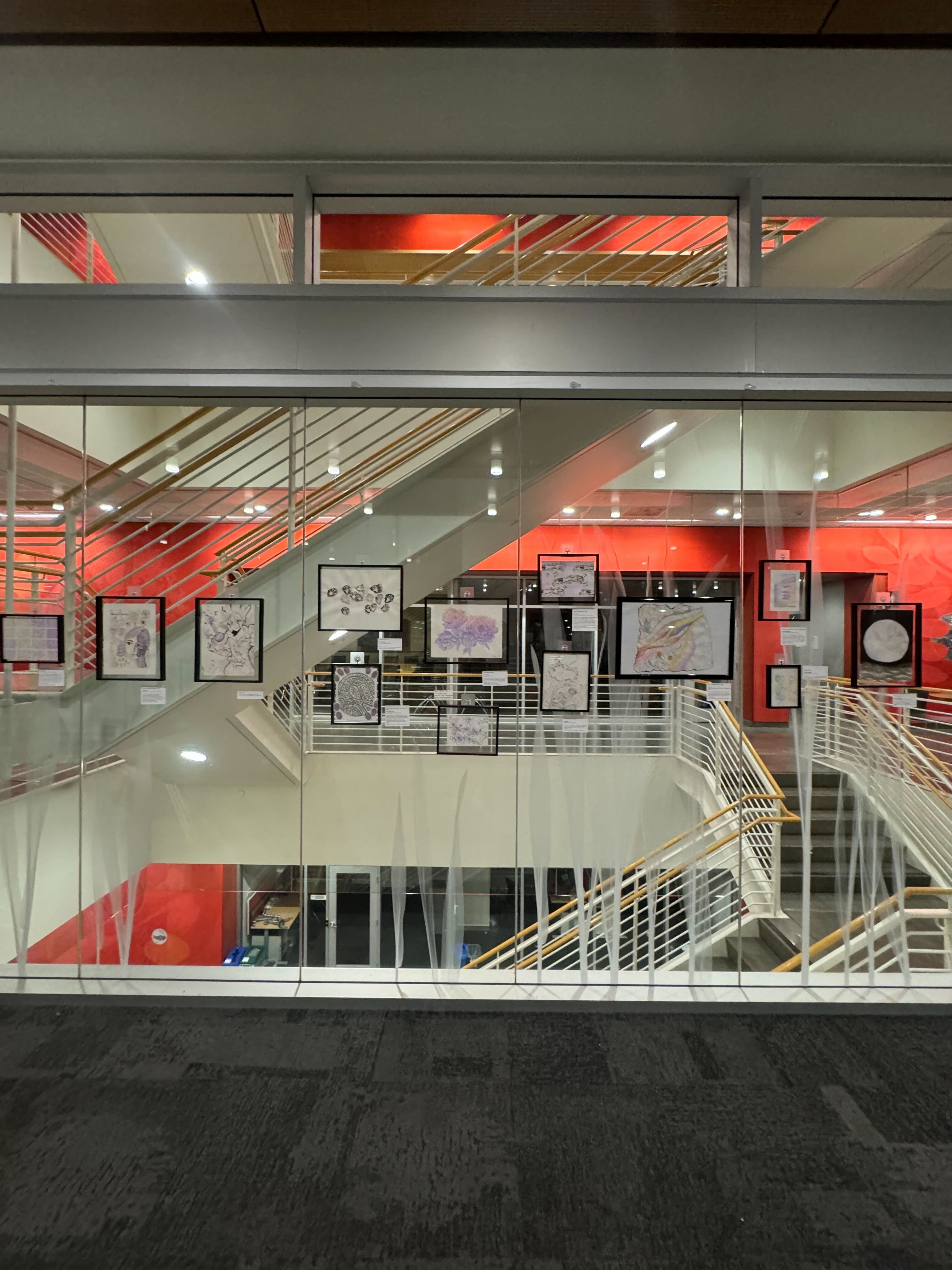On display in Shriram Center’s Tea Room are watercolor paintings created from the same purple colors, depicting different pictures of a family, Dr. Stone from “Dr. Stone” and coral reefs. They were introduced as a part of the exhibition “From Petri Dish to Palette: Exploring Bacterial-Based Paint,” which was sponsored by the bioengineering department and StanfordArts through the Burt McMurtry Arts Initiative Fund. The exposition displayed various artworks by students.
Each art piece surprised viewers with bio-fluorescence when shined with black light, resulting from the works being painted with biopigments derived from a cell. From where and how did this cell-derived art come to be?
Helen Dang, the science program manager of bioengineering, was inspired to explore how synthetic biology can transform art, given her experience in the bioengineering field and role as a practicing artist herself.
Dang’s inquiry led her to ask other professionals in the bioengineering department on using synthetic biology to create pigment.
“I asked Jennifer Cochran, the senior associate vice provost for research, if it was possible to produce paint using synthetic biology,” Dang said, “And she said, ‘I don’t see why not.’”
Cochran’s response propelled Dang to explore more ways that biopigments have been utilized by companies that produce dyes and textiles by talking to industry professionals and bioengineering professors. The program manager kickstarted her journey last summer with the goal to bring biopigments to campus for painting.
Dang worked alongside the professors in the department to create biopigment, which she used to create paintings that were on display to commemorate the 20th anniversary of the department last fall.
This experience inspired her to apply for the Burt McMurtry Art Initiative, a fund that offers support to faculty members to drive interdisciplinary, explorative projects art projects at Stanford, to bring the “cell” to canvas.
In October, Dang and Jenn Brophy, an assistant professor of bioengineering, ran a workshop called “Grow-Your-Own Biopigments.” They taught students from multiple different disciplines on how to incorporate these biopigments into art. The occasion attracted 40 applications for 15 seats and hosted students from every school aside from the Graduate School of Business, according to Dang.
The event caught the attention of TAPS senior lecturer and costumer designer Becky Bodurtha, who decided to attend.
“I think it’s a really interesting combination of science and I’m interested in ways that we can collaborate between STEM and art,” Bodurtha said. “I’m interested in making textiles and dyes and it fell into my interests.”
Bodurtha created two different art pieces collectively entitled “EcoÉtoile.” She utilized the biopigments to create a dress and her other work was a drawing of the dress on a mannequin, using the biopigments as paint to create a ringed effect.
The lecturer’s background in costume design inspired her to explore the intersection of textiles and dyes. In the process, Bodurtha brought in many different fabrics and tested the pigment on the textile that she found most interesting.
“What interested me about this fabric was that it looked like bacteria and when I painted a dot on the fabric it grew into a ring,” she said.
The workshop’s intersection of art and STEM balances the two practices, rather than undermining one over the other, according to Bodurtha.
“There’s a lot of value put on STEM, some people put value in art, but often we’re not funded well,” she said. “This is such an amazing combination showing how new technology can support artistic practice and can illuminate what science can do.”
Rebecca Konte, a staff artist in residence with the Prakash Lab and workshop instructor, shared a similar sentiment.
“It was cool to use bio-based pigments because I’m familiar with watercolor,” Konte said. “But, bio-materials are different; they behave slightly differently. It was interesting to see how they mixed and changed over time.”
Dang’s friend and attendee Dan Drzal found the exhibit’s interdisciplinary nature a great introduction to bioengineering and a thoughtful method to foster excitement for the discipline of bioengineering, adding “different layers, more layers to the story.”
The art pieces left many attendees in awe. Drzal noticed how artist Jierui Fang M.S. ’25 utilized pigment shading in “Reef Diffusion” to convey coral reef endangerment on a spectrum of “unhealthy to healthy” and “Family Portrait” by Brophy’s daughter Lily Caliando, which depicts a drawing of Caliando and her family.
Attendee and bioengineer Kelly Chou M.S. ’26 also found the exhibit fascinating. The biopigment artworks included many different themes of human connection with biology.
“So many of these students are in the science department,” she said. “I love to see their expression of art and oftentimes it’s through their lens as a scientist.”
Clarification: This article was updated to reflect that the exhibition received support from StanfordArts through the Burt McMurtry Arts Initiative Fund, in addition to the bioengineering department.
